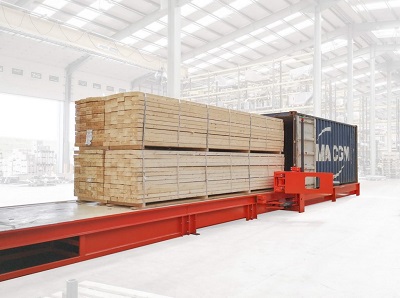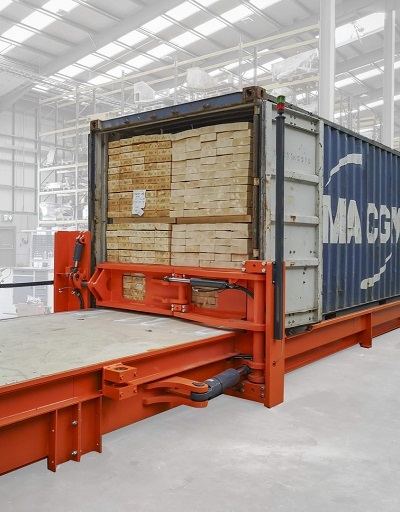Loading shipping containers is labor intensive, slow, and carries with it the risk of injury to operators as well as damage to goods. In the case of longer items like lumber or pipes, workers typically use one forklift to lift and maneuver products laterally in front of the container opening, and a second forklift to push the load into the container from the end. The process is time consuming and not particularly efficient.

The Combilift Container Slip-Sheet uses a hydraulic pulling mechanism to speed container loading.
Combilift, an Irish material-handling specialist with North American headquarters in Greensboro, N.C., has developed a mechanized method that reduces the need for manual handling and, therefore, increases safety. The Combilift Container Slip-Sheet (Combi-CSS) speeds up container loading while protecting the workforce.
The 30,000 kg (66,000 lb) capacity Combi-CSS is a low, free-standing platform with a dual-directional hydraulic pulling mechanism on which a steel sheet rests. A full load of product can be stacked on the sheet. Once prepared, the sheet is guided into the container by the underneath mechanism, which consists of four hydraulic cylinders moving in sequence. Hydraulic pins on the ends of the cylinders move up, fitting into holes cut into the sheet to secure it, while the cylinders pull the sheet forward, ensuring safe loading without any risk of product damage.
When fully loaded a hydraulic rear barrier gate, fixed to the end of the platform, swings across the container opening and locks in place. This holds the material within the container while the metal sheet is slipped out from underneath. A 20-ft container can be loaded in just three minutes and a 40-ft in just six minutes.

A hydraulic rear barrier gate holds the material in place while the steel sheet retracts.
One of the first Combi-CSS models was delivered to Fast Freight Srl, a Romanian a freight-forwarding company that wanted to improve its container loading procedures. Using the mechanized Combi-CSS system to load products such as steel pipes or timber into containers avoids a combination of forklifts and manual labor. According to the company, it significantly speeds up the process while increasing safety to operators and minimizing product damage.
“Safety and the reduction of risk across all operations is a major priority for us,” said Ioana Nedu, export sales representative, “and we use various Combilift products to handle the very diverse loads we ship around the world. The Combi-CSS has enabled us to enhance safety while also increasing capacity and margin per load.”
Combilift
combilift.com
Filed Under: Cylinders & Actuators, News